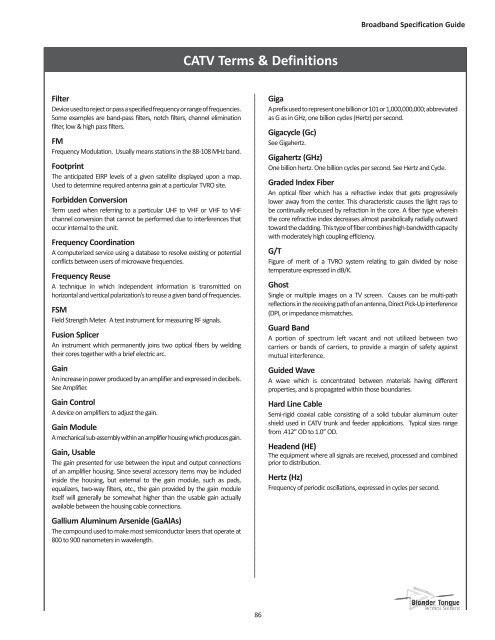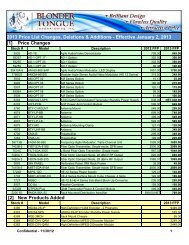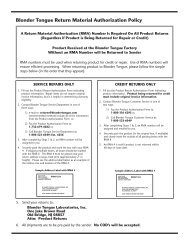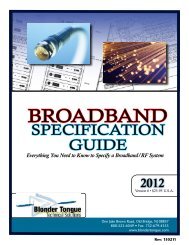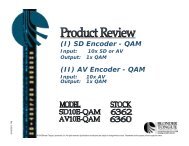Functional Block Diagram - Blonder Tongue Laboratories Inc.
Functional Block Diagram - Blonder Tongue Laboratories Inc.
Functional Block Diagram - Blonder Tongue Laboratories Inc.
You also want an ePaper? Increase the reach of your titles
YUMPU automatically turns print PDFs into web optimized ePapers that Google loves.
Broadband Specification Guide<br />
CATV Terms & Definitions<br />
Filter<br />
Device used to reject or pass a specified frequency or range of frequencies.<br />
Some examples are band-pass filters, notch filters, channel elimination<br />
filter, low & high pass filters.<br />
FM<br />
Frequency Modulation. Usually means stations in the 88-108 MHz band.<br />
Footprint<br />
The anticipated EIRP levels of a given satellite displayed upon a map.<br />
Used to determine required antenna gain at a particular TVRO site.<br />
Forbidden Conversion<br />
Term used when referring to a particular UHF to VHF or VHF to VHF<br />
channel conversion that cannot be performed due to interferences that<br />
occur internal to the unit.<br />
Frequency Coordination<br />
A computerized service using a database to resolve existing or potential<br />
conflicts between users of microwave frequencies.<br />
Frequency Reuse<br />
A technique in which independent information is transmitted on<br />
horizontal and vertical polarization’s to reuse a given band of frequencies.<br />
FSM<br />
Field Strength Meter. A test instrument for measuring RF signals.<br />
Fusion Splicer<br />
An instrument which permanently joins two optical fibers by welding<br />
their cores together with a brief electric arc.<br />
Gain<br />
An increase in power produced by an amplifier and expressed in decibels.<br />
See Amplifier.<br />
Gain Control<br />
A device on amplifiers to adjust the gain.<br />
Gain Module<br />
A mechanical sub-assembly within an amplifier housing which produces gain.<br />
Gain, Usable<br />
The gain presented for use between the input and output connections<br />
of an amplifier housing. Since several accessory items may be included<br />
inside the housing, but external to the gain module, such as pads,<br />
equalizers, two-way filters, etc., the gain provided by the gain module<br />
itself will generally be somewhat higher than the usable gain actually<br />
available between the housing cable connections.<br />
Gallium Aluminum Arsenide (GaAlAs)<br />
The compound used to make most semiconductor lasers that operate at<br />
800 to 900 nanometers in wavelength.<br />
Giga<br />
A prefix used to represent one billion or 101 or 1,000,000,000; abbreviated<br />
as G as in GHz, one billion cycles (Hertz) per second.<br />
Gigacycle (Gc)<br />
See Gigahertz.<br />
Gigahertz (GHz)<br />
One billion hertz. One billion cycles per second. See Hertz and Cycle.<br />
Graded Index Fiber<br />
An optical fiber which has a refractive index that gets progressively<br />
lower away from the center. This characteristic causes the light rays to<br />
be continually refocused by refraction in the core. A fiber type wherein<br />
the core refractive index decreases almost parabolically radially outward<br />
toward the cladding. This type of fiber combines high-bandwidth capacity<br />
with moderately high coupling efficiency.<br />
G/T<br />
Figure of merit of a TVRO system relating to gain divided by noise<br />
temperature expressed in dB/K.<br />
Ghost<br />
Single or multiple images on a TV screen. Causes can be multi-path<br />
reflections in the receiving path of an antenna, Direct Pick-Up interference<br />
(DPI, or impedance mismatches.<br />
Guard Band<br />
A portion of spectrum left vacant and not utilized between two<br />
carriers or bands of carriers, to provide a margin of safety against<br />
mutual interference.<br />
Guided Wave<br />
A wave which is concentrated between materials having different<br />
properties, and is propagated within those boundaries.<br />
Hard Line Cable<br />
Semi-rigid coaxial cable consisting of a solid tubular aluminum outer<br />
shield used in CATV trunk and feeder applications. Typical sizes range<br />
from .412” OD to 1.0” OD.<br />
Headend (HE)<br />
The equipment where all signals are received, processed and combined<br />
prior to distribution.<br />
Hertz (Hz)<br />
Frequency of periodic oscillations, expressed in cycles per second.<br />
86


